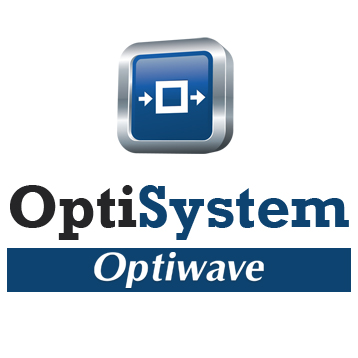Attenuators, couplers and splitters, combiners, polarization controllers, and reflectors are all examples of optical devices. There are also 180- and 90-degree hybrid couplers, power splitters, combiners, and power blockers. There are many optical and electrical filters that can be used to simulate sub-systems and systems, including standard filter functions such as Gaussian, RC, and Raised Cosine. Digital IIR/FIR filters and periodic filters are available. The award-winning OptiSystem reduces time and costs for designing optical links, components, systems, and systems. This is a critical industry area. Our Mission is to provide high-quality, cutting-edge design automation software that meets the needs of all segments of the photonics sector, including nano-components, optical components, systems, and complete optical network design.
Optiwave Optisystem
Password 123
The Receivers library includes all of the building blocks required to model optical communication receiver subsystems accurately. The components include regenerators (3R), electronic equalizers and threshold detectors, decision circuits to modulate PSK/QAM/PIN, APD photo-detectors, and demodulators. Digital signal processing tools for single and dual-polarization coherent PSK, and QAM systems.
Optiwave Optisystem Feauters
OptiSystem, a powerful, innovative, and rapidly evolving software design tool allows users to simulate, plan, and test almost any type of optical link in the transmission layers of a wide range of optical networks, from LAN, SAN, and MAN to ultralong-haul. It allows for transmission layer optical communication system planning and design from component to system levels, and visual analysis and scenarios. Optiwave is a leader in the development and use of innovative software tools to design, simulate, and optimize components, links, and systems for photonics nanotechnology, optoelectronics, and optical networks. A wide range of passive and active optical components are available to create a variety of sub-system and component designs.
OptiSystem’s components are able to model optical channels in free space and perform spatial analysis of multimode signal coupling between devices (multimode generators, spatial connectors thin lenses, spatial visualizers), as well as spatial modeling of multi-mode signals. OptiSystem was created to meet the needs of researchers, optical telecom engineers, and system integrators as well as students. It also meets the growing demand for an easy-to-use tool to design optical systems. Since 1994, Optiwave software has been licensed to over 1000 companies and universities from more than 70 countries.

Advanced visualization tools can produce OSA Spectra and signal chirp. Eye diagrams, polarization states, constellation diagrams, and more. WDM analysis tools are also included, listing signal power, gain, and noise figure for each channel. These functions and operations include signal addition, subtraction, bias generators, gain and signal addition, normalizers as well as down-samplers.
They also support serial-parallel or parallel-serial conversions, flip flops, and other binary logic operators. Advanced optical fiber models that are highly parametrized can be used for characterizing single-mode and multi-mode signals propagation. This includes linear, stochastic, and nonlinear impairments like FWM, self-phase, and cross-phase modulation. OptiSystem’s Bidirectional optical fiber component makes it possible to model and measure Rayleigh and Brillouin scattering effects. It is important to have models at various abstraction levels in order to make a simulation tool flexible, efficient and flexible. This includes the system, subsystem, and component levels. OptiSystem has a hierarchical description of components and systems that allows for the simulation to be as precise as required.
How to Get Optiwave Optisystem for Free
Parameters can be entered using arithmetical expressions and global parameters can be shared among components and subsystems by using the standard VB Script language. The script language is able to manipulate and control OptiSystem. It can do calculations, layout creation, and post-processing. OptiSystem offers a cost analysis table for the system being designed. It can be arranged by system layout, component, or system.
OptiSystem uses numerical analysis and semi-analytic techniques to calculate parameters such as BER or Q-Factor in order to predict system performance. This is useful for systems that are limited by inter-symbol noise and interference. OptiSystem can handle mixed signals for both optical and electrical signals from the Component Library. OptiSystem calculates signals using appropriate algorithms that are related to simulation accuracy and efficiency.
Select component ports can be used to save data and attach monitors at the end of the simulation. Our Vision is to enable the worldwide use of photonics by leading the development and growth of a global Photonics Automation industry. AEC productivity enhancements include variable curtain walls and more sophisticated handling of concrete rebar. You can display any combination of parameters or results in the design on a fully customizable report page. The reports can be resized and moved into spreadsheets, text, and 3D graphs.
Optiwave’s photonic design automation software, and custom engineering design services, offer customers a competitive advantage. They dramatically reduce time to market and improve quality, productivity, and cost-effectiveness. The models allow designers to use measured data to determine device transfer functions. This includes small-signal scattering matrixes and the Jones matrix. There are ideal and non-ideal models available for network design tools such as optical switches, multiplexers, and de-multiplexers.
They also include array waveguides, fiber connectors, and PMD emulators. For modeling the dynamic and static behavior of semiconductor lasers, designers can choose from either advanced measurement-based or physical-based models. Our physical-based models can be used to create 1D or 2D multimode laser rate equations. This allows designers to switch between bulk and transmission line matrix models. Multiple designs can be created from the same project file. This allows you to quickly create and modify designs. Although design versions can be modified and calculated separately, calculation results can be combined across multiple versions to allow for comparisons.
Optiwave Optisystem System Requirements
- Operating System: Windows 7/8/8.1/10
- Memory (RAM): 8 GB of RAM required.
- Hard Disk Space: 100 MB of free space required.
- Processor: Intel Core i7 or later.
